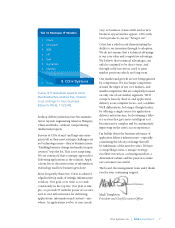Citrix 2006 Annual Report Download - page 19
Download and view the complete annual report
Please find page 19 of the 2006 Citrix annual report below. You can navigate through the pages in the report by either clicking on the pages listed below, or by using the keyword search tool below to find specific information within the annual report.
Citrix Systems, Inc. Annual Report
• Non-annual grants to newly hired and promoted
employees and from time to time to officers in
recognition of performance or as incentives.
Beginning January 2004, we replaced promotion
grants with performance grants that were
granted to employees upon recommendation
by their manager for recognition (new hire and
performance, incentive or promotion grants are
referred to collectively as non-annual grants).
• Options granted or assumed in connection
with acquisitions.
• Options granted to non-employee members of our
Board of Directors.
From December 1995 through mid-1998, all employee
grants required approval by the Compensation Committee
to complete the required granting actions. In addition, we
did not have a defined process for determining the date on
which we made grants and no granting pattern could be
established for grants made during this period. Following
the investigation, the Audit Committee concluded that we
likely set grant dates retrospectively for many stock options
granted to employees and executives during the 1996 to
mid-1998 period.
Beginning in mid-1998 through late 2003, all employee
grants required approval by the Compensation Committee
to complete the required granting actions. During this
period, we made changes in our stock option granting
practices which included implementing a practice where
we typically dated non-annual grants to non-executives
on the first business day of the month following the start
or promotion date, unless that date was the first day of
the month, in which case the grant date would be that
date. We dated non-annual new hire and promotion
grants to executives either on their start date or the first
business day of the month following the start date or the
promotion date; we awarded the incentive grants on an
ad hoc basis. During this period, we made annual grants
to executive and non-executive employees on dates that
were typically previously discussed with the Compensation
Committee. However, during these earlier discussions, the
Compensation Committee did not approve the terms and
allocation of grants to individual recipients or delegate to
management the authority to do so without further action
by the Compensation Committee. Until 2002, annual
grants were generally made in July or August of each year
pursuant to a merit evaluation process. Beginning in 2002,
annual grants were split into two grant dates in March and
August. During this period all employee grants required
approval by the Compensation Committee to complete
the required granting actions and for most grants we did
not obtain approval from the Compensation Committee,
typically on unanimous written consent forms, until after the
grant date and for certain grants, we had not completed
the process of identifying the recipients or number of
options to be granted until after the grant date.
Beginning in November 2003, the Compensation
Committee delegated its authority to our Chief Executive
Officer and Chief Financial Officer to issue stock options
pursuant to specific parameters. The delegation provided
authority to grant no more than 4 million stock options per
year in the aggregate and to grant up to 10,000 options
per year to any employee who was not an officer subject
to Section 16 of the Securities Exchange Act of 1934, as
amended, and whose compensation was not subject to
Section 162(m) of the Internal Revenue Code of 1986 as
amended, or the IRC. In July 2004 the Compensation
Committee increased that number to 20,000 options per
employee per year. The delegation was also subject to
other parameters, including that each grant be consistent
in number with guidelines that provided the range of
grants that could be awarded to each employee grade.
Compensation Committee approval continued to be a
required granting action for all stock option grants outside
of the parameters of the delegated authority. For grants
outside of the delegation of authority, the Compensation
Committee often approved such grants at a meeting or
by unanimous written consent form. In some cases the
amount granted to each recipient was not final and/or the
Compensation Committee had not approved the grants by
the intended grant date.
We also made grants to the employees of companies we
acquired in connection with acquisitions. Grants made
in conjunction with acquisitions were typically authorized
at the time of the Board’s approval of the acquisition.
The exercise price of such grants was typically set at the
closing stock price of our common stock on the closing
date of the acquisition. During the investigation, we noted
























